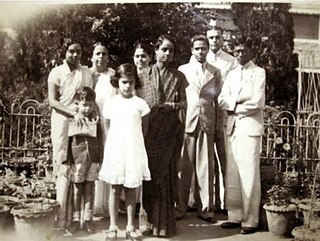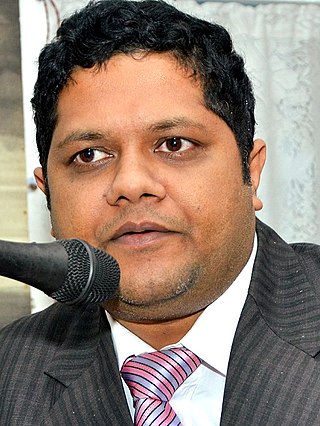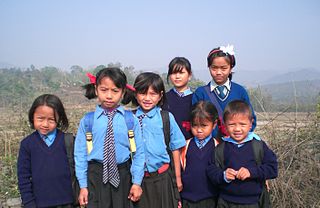Related Research Articles

Meghalaya is a state in northeast India. Meghalaya was formed on 21 January 1972 by carving out two districts from the state of Assam: (a) the United Khasi Hills and Jaintia Hills and (b) the Garo Hills. The estimated population of Meghalaya in 2014 was 3,211,474. Meghalaya covers an area of approximately 22,429 square kilometres, with a length-to-breadth ratio of about 3:1.

Shillong is a hill station and the capital of Meghalaya, a state in northeastern India. It is the headquarters of the East Khasi Hills district. Shillong is the 330th most populous city in India with a population of 143,229 according to the 2011 census. It is said that the rolling hills around the town reminded the British of Scotland. Hence, they would also refer to it as the "Scotland of the East".

The Khasi people are an ethnic group of Meghalaya in north-eastern India with a significant population in the bordering state of Assam, and in certain parts of Bangladesh. Khasi people form the majority of the population of the eastern part of Meghalaya, that is Khasi Hills, constituting 78.3% of the region's population, and is the state's largest community, with around 48% of the population of Meghalaya. They are among the few Austroasiatic-speaking peoples in South Asia. The Khasi tribe holds the distinction of being one of the few remaining tribes that have a matrilineal society. Under the Constitution of India, the Khasis have been granted the status of Scheduled Tribe.

Ri Bhoi is an administrative district in the state of Meghalaya in India. The district headquarters are located at Nongpoh. The district occupies an area of 2378 km² and has a population of 258,840. As of 2011 it is the second least populous district of Meghalaya, after South Garo Hills.

West Garo Hills is an administrative district in Garo Hills of the state of Meghalaya in India. Tura town is the administrative headquarters of the district. The district occupies an area of 3714 km². In 2011, its population was 643,291. As of 2011, it is the second most populous district of Meghalaya, after East Khasi Hills.

Kamrup Rural district, or simply Kamrup district, is an administrative district in the state of Assam in India formed by dividing the old Kamrup district into two in the year 2003; other being Kamrup Metropolitan district, named after the region it constitutes. This district, along with Nalbari, Barpeta, Kamrup Metropolitan, Bajali and Baksa districts has been created from the Undivided Kamrup district.

The Garo people are a Tibeto-Burmese ethnic group who live mostly in the Northeast Indian state of Meghalaya with a smaller number in the neighbouring Bangladesh. Historically, the name Garo was used for a large number of different peoples living on the southern bank of Brahmaputra River, but now refers primarily to those who call themselves A•chik Mande or simply A•chik or Mande and the name "Garo" is now being used by outsiders as an exonym. They are the second-largest tribe in Meghalaya after the Khasi and comprise about a third of the local population.

The Khasi Hills are a low mountain formation on the Shillong Plateau in the Meghalaya state of India. The Khasi Hills are part of the Garo-Khasi-Jaintia range and connect with the Purvanchal Range and larger Patkai Range further east. The Khasi Hills, and the whole Garo-Khasi-Jaintia range, are in the Meghalaya subtropical forests ecoregion.

Langpih, also spelt Langpi, Lampi, or Lumpi is a village in northeast India. It is located near the border of West Khasi Hills district, Meghalaya and Kamrup district, Assam. In Meghalaya's administrative structure, it is under Kyrdum gram panchayat, Mawshynrut block, West Khasi Hills district, whereas Assam assigns it to No. 9 Dakhin Pub Boko gram panchayat, Boko-Bongaon block, Kamrup district, with the Postal Index Number 781129.

The Hynniewtrep National Liberation Council is a militant organization operating in Meghalaya, India. It claims to represent the Khasi-Jaintia tribal people, and its aim is to free Meghalaya from the alleged domination of outsiders from the Indian mainland. It was proscribed in India on 16 November 2000, but the ban was later lifted, before banning it again in 2019.

The Koch are a small trans-border ethnic group of Assam and Meghalaya in India and northern Bangladesh. The group consists of nine matrilineal and strictly exogamous clans, with some of them preserving a hitherto sparsely documented Boro-Garo language called Koch, whereas others have switched to local varieties of Indo-Aryan languages. It is a Scheduled Tribe in Meghalaya, India. Koches want to preserve language and culture and heritage.
Williamson Ampang Sangma, was a Garo leader, and the first Chief Minister of Meghalaya. He was also the first Governor of Mizoram among the Garos in 1989.
Evangelization of Meghalaya began in the 19th century during the British era. In the 1830s, American Baptist Foreign Missionary Society had become active in Northeast to evangelize indigenous tribes to Christianity. Later, they were offered to expand and reach into Sohra Meghalaya, but they lacked the resources to do so and declined. Welsh Presbyterian Mission took the offer and they began work at Sohra mission field. By the early 1900s, other Protestant denominations of Christianity were active in Meghalaya. The outbreak of World Wars forced the preachers to return home to Europe and America. It is during this period that Catholicism took root in Meghalaya and neighbouring region. Currently, Catholics, Presbyterians and Baptists are three most common Christian denominations found in Meghalaya.

The Insurgency in Meghalaya is a frozen armed conflict between India and a number of separatist rebel groups which was taking place in the state of Meghalaya. The Insurgency in Meghalaya is part of the wider Insurgency in Northeast India, and was fueled by demands of the Khasi, Synteng and Garo people for a separate state.
Silverine Swer (1910–2014), popularly known as Kong Sil, was an Indian social and environmental activist, educationist and civil servant. She was the first person of tribal origin to hold senior posts with the Government of Meghalaya, and was a recipient of the Silver Elephant Medal of the Bharat Scouts and Guides Award and Kaisar-i-Hind Medal. The Government of India awarded her the fourth highest civilian award of Padma Shri in 1990, making her the first recipient of the award from the state of Meghalaya.

Rejaul Karim Laskar is an Indian politician and scholar of India's foreign policy. He is a former Congress ideologue and has written extensively on the policies of the United Progressive Alliance governments. He is also an eminent scholar of India's foreign policy and diplomacy with his scholarly work having been recognized as constituting a "a major contribution to contemporary diplomatic history" of India.
This is a timeline of the Insurgency in Northeast India, an ongoing armed conflict between the separatist rebels and the Indian government.

The hill tribes of Northeast India are hill people, mostly classified as Scheduled Tribes (STs), who live in the Northeast India region. This region has the largest proportion of scheduled tribes in the country.

Legislative Assembly elections were held in Meghalaya on 27 February 2023 to elect all 60 members of the Meghalaya Legislative Assembly. The votes were counted and the results were declared on 2 March 2023.
References
- ↑ "Title of the Article". Kolkata Observer. 13 July 2011. Archived from the original on 13 July 2011. Retrieved 3 April 2024.
- 1 2 3 4 5 "LANGPIH- THE CRY OF THE RIMULIANG" (PDF). Journal of Emerging Technologies and Innovative Research.
- 1 2 3 "Cops object to stage at Langpih", The Telegraph of India, Calcutta, India, 29 June 2012, archived from the original on 9 July 2012, retrieved 11 August 2012
- ↑ "Centre to probe firing across Assam-Meghalaya border", OneIndia.in, 19 May 2010, retrieved 10 August 2010
- ↑ Roy, Dipankar; Sarma, Pankaj (16 May 2010), "Lampi: a victim of one-upmanship; Progress eludes 'apple of discord'", The Telegraph, Calcutta, India, archived from the original on 19 May 2010, retrieved 18 August 2010
- ↑ "Assam Police Fails to Disrupt Langpih Fast", Northeast Today, 2 July 2012, archived from the original on 18 February 2013, retrieved 11 August 2012
- ↑ "Fast over Langpih enters Day Eight; No solution to imbroglio in sight", The Telegraph of India, Calcutta, India, 9 July 2012, archived from the original on 4 March 2016, retrieved 11 August 2012
- ↑ "Sangma petitions Delhi on Langpih". The Telegraph of India. Calcutta, India. 11 July 2012. Archived from the original on 17 July 2012. Retrieved 11 August 2012.
- ↑ "Hunger strike at Langpih to be withdrawn tomorrow", Business Standard, 13 July 2012, retrieved 11 August 2012
- ↑ "Langpih protesters end fast unto death", The Shillong Times, 13 July 2012, retrieved 11 August 2012
- ↑ "Youth resumes fast unto death at hospital". The Telegraph. Calcutta, India. 16 July 2012. Archived from the original on 22 August 2014. Retrieved 11 August 2012.
- ↑ "India yet to submit th elong pending Assam-Meghalaya Border dispute to the UN", TNT Magazine, 1 August 2012, retrieved 11 August 2012
- ↑ "Assam-Meghalaya Border Dispute". Land Conflict Watch. Retrieved 29 March 2024.
- ↑ "Situation Tense Along Assam-Meghalaya Border After Fresh Clashes Erupt". The Wire. Retrieved 29 March 2024.